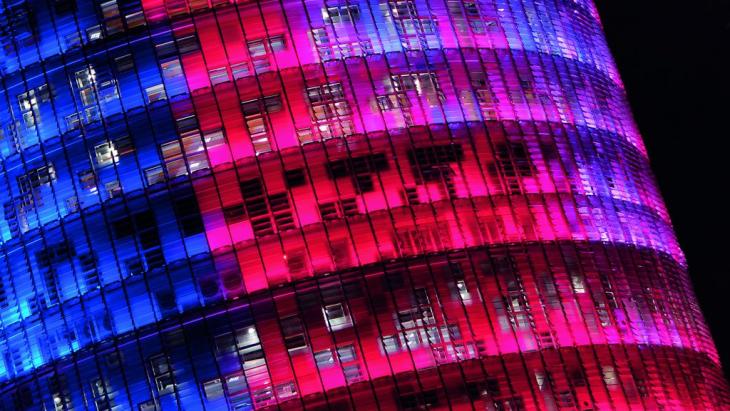Points of interest in the city
Barcelona and architecture at its most avant-garde

A 21st century city
True to its creative, modern and innovative spirit, Barcelona continues to reinvent its urban landscape. Alongside the architectural legacy of the city's golden times, such as the Middle Ages, with its extraordinary Gothic buildings that can still be admired and touched today, we can enjoy Modernisme, which from the late nineteenth century to the first third of the twentieth covered the city with architectural gems. Today, this wealth coexists with monumental spaces planned over the last twenty years.
Avant-garde architecture
Barcelona's contemporary architecture is prolific, almost impossible to quantify: organising the 1992 Olympic Games meant an urban planning revolution, with which the city faced the future, the 21st century, preparing itself to be, once again, a reference for the avant-garde. Barcelona recovered its pride, opening itself up to the sea, watching whole districts grow, paradigms of post-modern and humanist architecture, such as the Olympic Village, a brick oasis built on top of old industrial Barcelona, and the new Port Vell, with a wharf that enters the sea like a tongue of wood. At one end, a huge, colourful pop art sculpture in the form of a female face, the work of American Roy Lichtenstein, announced to the four winds the inevitable: the city, boldly and steadily, was knocking on the door of the 21st century. A statement of intent that has been more than fulfilled.
From MACBA to the TNC
From that time also comes the stunning white bulk that rises in the heart of the Raval: the modern art museum, the Barcelona Museum of Contemporary Architecture (MACBA), an example of advanced rationalism, the work of the American Richard Meier; and Palau Sant Jordi, halfway up Montjuïc mountain, by the Japanese Arata Isozaki, as well as the telecommunications tower, 136 metres tall and known as the Torre Calatrava, a piece of white steel with an amazing outline. Years later saw the flourishing of the new Botanical Garden, on the other side of Montjuïc, proof of the wonders that human action is capable of imposing on the natural landscape. The city's other mountain, Collserola, houses another contemporary icon: the Torre de Collserola, 288 metres tall and including a viewpoint on the tenth floor. It was designed by the British architect Norman Foster. Music and theatre were also honoured there, with the construction of new cultural spaces such as the Auditori, one of the city's major musical centres, designed by Rafael Moneo and another example of modern rationalism. Its central atrium, a huge cubic glass lantern is one of the jewels of the building. Close by and next to Plaça de les Glòries, rises the monumental Teatre Nacional de Catalunya, a spectacular building in the style of a Greek temple, the work of architect Ricard Bofill.
Radically Contemporary
Once the 21st century arrived, the creative thrust continued in Barcelona at full steam, forging ahead with its definitive transformation towards modernity. Evidence of this includes the biomedical park, the Biomedical Research Park, next to the beach, which is an architectural work of genius, and the futuristic Jaume Fuster Library in Gràcia. A commitment to modernisation can also be seen in the old spaces that have been reclaimed and adapted to contemporary architecture. Such is the case with Can Framis, the eighteenth-century factory located in Poblenou and converted into the Vila Casas Foundation Museum, and Can Felipa and Can Ricart, the old factory premises also located in Poble Nou and which are now home to a whole host of social and artistic activities.
One of the emblems of contemporary Barcelona is without doubt the Mercat de Santa Caterina, in Ciutat Vella. Enric Miralles and Benedetta Tagliabue's renovations have converted the old market into a truly original space that maintains its essence. The spectacular and colourful undulating roof is an absolute spectacle.
From 22@ to the parks
The new millennium was marked with an incredible icon that forever changed the city's skyline: the Torre Agbar tower by Jean Nouvel, in Plaça de les Glòries, a glass-covered round-tipped cylinder 144 metres high with variously coloured windows. And if is there is a single neighbourhood that concentrates more blatant architectural innovation than any other, it is 22 @, the hub of innovation. The Barcelona Growth Centre is a paradigm of this new architecture: a futuristic-looking building constructed using sustainability and efficiency criteria.
The city's parks are certainly the places where the contemporary imagination has flowed the most freely. The most audacious public sculptures are scattered across the modern parks of Parc Central de Nou Barris, Estació del Nord, Espanya Industrial, Clot and Diagonal Mar. Parc del Fòrum, a wide open and almost spartan area, one of the places that best represents the radical transformation of this edge of the city, next to the Besòs river.


